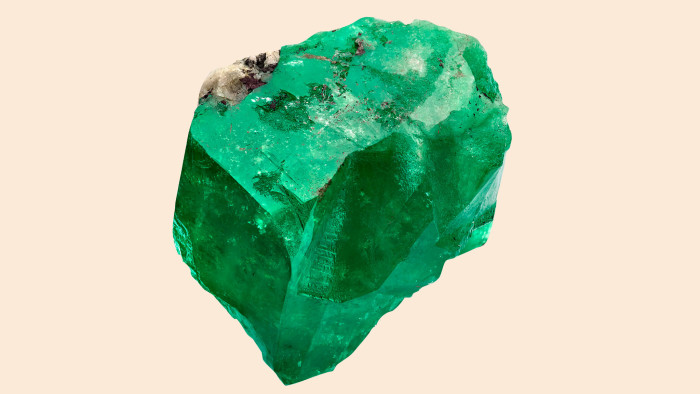Jewellery news in brief: emerald collectors green with envy at sale

Roula Khalaf, Editor of the FT, selects her favourite stories in this weekly newsletter.
New York auction house Guernsey’s will put the Marcial de Gomar emerald collection under the hammer on April 25. It includes La Gloria, at 887ct the largest rough emerald in North America from Colombia’s Muzo mines. Manuel Marcia de Gomar started mining emeralds in 1955 and became a wholesaler in the 1960s, as well as a court-recognised “emerald expert”. In June, Guernsey’s will also sell a set of four star rubies discovered in Appalachia in 1990, the Mountain Star Ruby Collection. The stones are so called because they have a six-armed star on their surfaces. The largest is the 139ct Appalachian Star.
Paris-Tokyo rally
From April 29 to August 6, “Mastery of an Art: Van Cleef & Arpels — High Jewelery and Japanese Crafts” will examine Japanese and French workmanship side by side at the National Museum of Modern Art in Kyoto. The exhibition will illustrate the jeweller’s 120-year history through brooches, clips and pendants from its archive, while the contemporary, often intricate, Japanese artwork on display will include weaving, ceramics, lacquer and metalwork. Kyoto — Japan’s capital from the late eighth century to the start of the Meiji Restoration in 1868 — has a particularly rich textile heritage, highlighted by Kunihiko Moriguchi, a government-recognised “living national treasure” in yuzen dyeing, used for kimonos.
Egg-citing
In search of a broader audience in Asia, Fabergé will host a series of private viewings of its jewellery across Hong Kong and Singapore in May. This follows the February debut of its jewellery, timepieces and objets d’art at a series of private brunches, cocktail evenings and appointments in India, where the Winter Egg from its new Four Seasons collection was unveiled. (The original Winter Egg was an Easter gift in 1913 from Tsar Nicholas II to his wife, and it sold at auction for $9.6m in 2002.) The jeweller was founded in imperial Russia by Peter Carl Fabergé and nationalised in 1918 by the Bolsheviks, but was relaunched in 2009 and acquired by mining company Gemfields in 2013.
Mercurial

Brilliant Earth, the ethically-sourced fine jewellery retailer, is supporting a project to teach artisanal gold miners in the Peruvian rainforest how to mine without mercury. The miners traditionally use toxic mercury to bind fragments of gold together, then burn them — releasing the mercury into the air and leaving the gold behind. The programme, run by charity Pure Earth, will benefit an association of 400 miners in Huepetuhe, an area placed under a state of emergency last year due to mercury contamination, and where mining activity has taken over more than 100 sq km of rainforest.
Modern motif

This month Boodles will introduce a 68.6ct cushion-cut Brazilian imperial topaz ring to its high jewellery collection. The rectangular burnt-yellow/orange stone is surrounded by tiny round brilliant-cut diamonds and set lengthways on an 18ct yellow gold openwork wheatsheaf design with marquise-cut white diamonds. It is a contemporary take on the popular Victorian motif. The stone was spotted in a Victorian pendant by Boodles’ chairman Nicholas Wainwright, who bought it as a family heirloom and arranged for it to be recut and polished.
Upside down

Graff is turning the design process on its head in a new collection of rings with stones that are cut according to their setting, rather than basing the setting on the stones available. “We use custom-cut stones to give designs a dynamic flair,” says design director Anne-Eva Geffroy. Each month the jeweller’s polishing and procurement division cuts and polishes thousands of carats in Johannesburg, Botswana and Antwerp. The collection includes a 9ct pear-shape fancy vivid pink diamond and a 14.2ct emerald.
Frosty reception

In January, Audemars Piguet launched its Ladies Royal Oak Frosted Gold watch, featuring jeweller Carolina Bucci’s Florentine gold finish on its casing and strap. Now Ms Bucci has launched her own range of pendants using the same centuries-old technique. The shimmering effect is made by hand-beating gold with a diamond-tipped tool, leaving tiny dents in the metal. Like every piece by the fourth-generation jeweller, these heart, horn and matchstick charms in 18ct yellow, white, pink or black gold will be created in her family’s Florentine workshop.
Comments